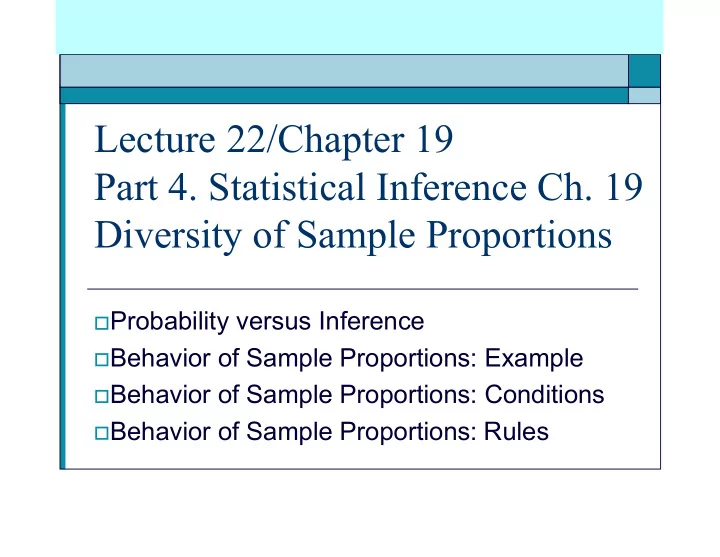

Lecture 22/Chapter 19 Part 4. Statistical Inference Ch. 19 Diversity of Sample Proportions Probability versus Inference Behavior of Sample Proportions: Example Behavior of Sample Proportions: Conditions Behavior of Sample Proportions: Rules
Course Divided into Four Parts (Review) Finding Data in Life: 1. scrutinizing origin of data Finding Life in Data: summarizing data 2. yourself or assessing another’s summary Understanding Uncertainty in Life: 3. probability theory (completed) Making Judgments from Surveys and 4. Experiments: statistical inference
Approach to Inference Step 1 (Chapter 19): Work forward ---if we happen to know the population proportion falling in a given category, what behavior can we expect from sample proportions for repeated samples of a given size? Step 2 (Chapter 20): Work backward ---if sample proportion for a sample of a certain size is observed to take a specified value, what can we conclude about the value of the unknown population proportion? After covering Steps 1&2 for proportions, we’ll cover them for means.
Understanding Sample Proportion 3 Approaches: 1. Intuition 2. Hands-on Experimentation 3. Theoretical Results We’ll find that our intuition is consistent with experimental results, and both are confirmed by mathematical theory .
Example: Intuit Behavior of Sample Proportion Background : Population proportion of blue M&M’s is 1/6=0.17. Question: How does sample proportion behave for repeated random samples of size 25 (a teaspoon)? Response: Summarize by telling ________________________________ Experiment: sample teaspoons of M&Ms, record sample proportion of blues on sheet and in notes (need a calculator)
Example: Intuit Behavior of Sample Proportion Background : Population proportion of blue M&M’s is 1/6=0.17. Note: The shape of the underlying distribution (sample size 1) will play a role in the shape of sample proportions for various sample sizes. 5/6 1/6 sample proportion of 0 1 blues in samples of size 1
Example: Intuit Behavior of Sample Proportion Response: (continued) Center: some sample proportions will be less than 0.17 and others more; the mean of all sample proportions should be ______________________ Spread : depends on sample size; if we’d sampled only 5, we’d easily get sample proportions ranging from 0 to 0.6 or 0.8. For samples of 25, proportions ______________________________ Shape: proportions close to _____ would be most common, and those far from ______ increasingly less likely---shape ________________________
Example: Intuit Behavior of Sample Proportion Background : Population proportion of blue M&M’s is 1/6=0.17. Question: How does sample proportion behave for repeated random samples of size 75 (a Tablespoon)? Response: Again, we summarize by telling _______________________ Now sample Tablespoons of M&Ms, record sample proportion of blues on sheet and in notes (need a calculator)
Example: Intuit Behavior of Sample Proportion Response: (samples of size 75) Center: The mean of all sample proportions should be _______________________, regardless of sample size. Spread : should be ______ than what it would be for samples of size 25. Shape: should bulge more close to 0.17, taper more at the ends, less right-skewness: it should be _____________
Conditions for Rule of Sample Proportions Randomness [affects center] Can’t be biased for or against certain values Independence [affects spread] If sampling without replacement, sample should be less than 1/10 population size Large enough sample size [affects shape] Should sample enough to expect at least 5 each in and out of the category of interest.
Example: Checking Conditions for Rule Background : Population proportion of blue M&M’s is 1/6=0.17. Students repeatedly take random samples of size 1 teaspoon (about 25) and record the proportion that are blue. Question: Are the 3 Conditions met? Response: ________________________________________ 1. ________________________________________ 2. ________________________________________ 3.
Example: Checking Conditions (larger sample) Background : Population proportion of blue M&M’s is 1/6=0.17. Students repeatedly take random samples of size 1 Tablespoon (about 75) and record the proportion that are blue. Question: Are the 3 Conditions met? Response: ________________________________________ 1. ________________________________________ 2. ________________________________________ 3.
Rule for Sample Proportions Center: The mean of sample proportions equals the true population proportion. Spread: The standard deviation of sample proportions is standard error = population proportion × (1-population proportion) .. sample size Shape: (Central Limit Theorem) The frequency curve of proportions from the various samples is approximately normal.
Example: Applying Rules for Sample Proportions Background : Proportion of blue M&Ms is 1/6=0.17. Question: What does the Rule tell us about sample proportions that are blue in teaspoons (about 25)? Response: Center: the mean of sample proportions will be ______ Spread: the standard deviation of sample proportions will be standard error = Shape: __________________________
Example: Applying Rules for Sample Proportions Background : Proportion of blue M&Ms is 1/6=0.17. Question: What does the Rule tell us about sample proportions that are blue in Tablespoons (about 75)? Response: Center: the mean of sample proportions will be ______ Spread: the standard deviation of sample proportions will be standard error = Shape: __________________________
Empirical Rule (Review) For any normal curve, approximately 68% of values are within 1 sd of mean 95% of values are within 2 sds of mean 99.7% of values are within 3 sds of mean
Example: Applying Empirical Rule to M&Ms Background : Population proportion of blue M&M’s is 1/6=0.17. Students repeatedly take random samples of size 1 Tablespoon (about 75) and record the proportion that are blue. Question: What does the Empirical Rule tell us? Response: 68% of the sample proportions should be within ________________: in [0.127, 0.213] 95% of the sample proportions should be within ________________: in [0.084, 0.256] 99.7% of the sample proportions should be within ________________: in [0.041, 0.299] How well did our sampled proportions conform?
Proportions then Means, Probability then Inference Next time we’ll establish a parallel theory for means, when the variable of interest is quantitative (number on dice instead of color on M&M). After that, we’ll Perform inference with confidence intervals For proportions (Chapter 20) For means (Chapter 21) Perform inference with hypothesis testing For proportions (Chapters 22&23) For means (Chapters 22&23)
Recommend
More recommend